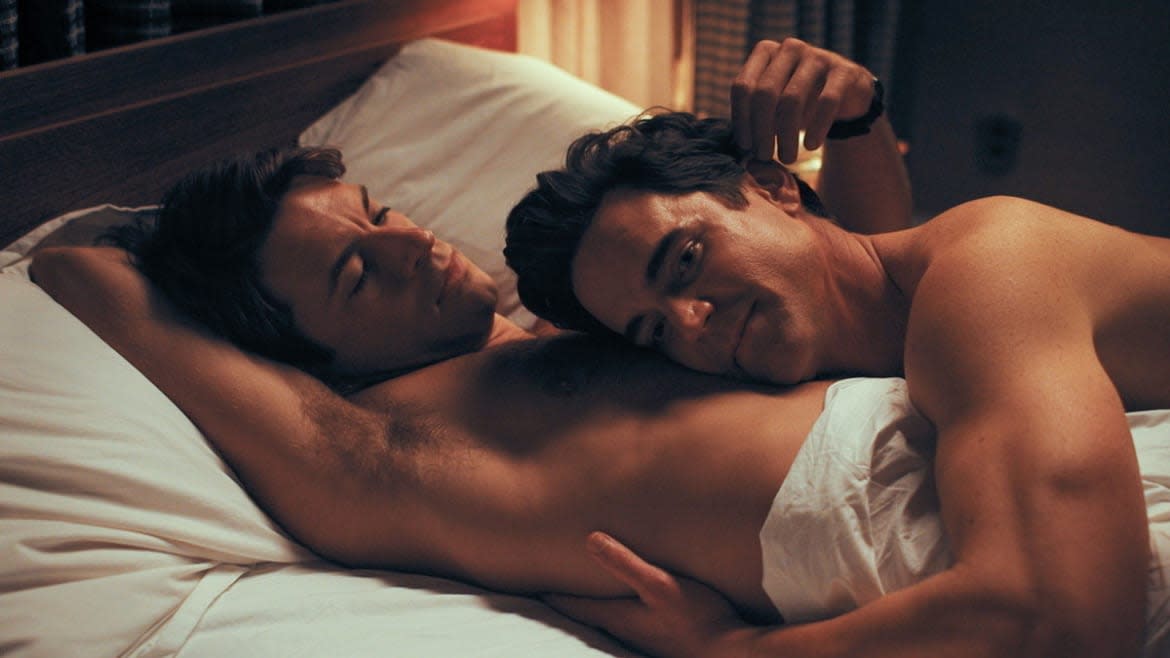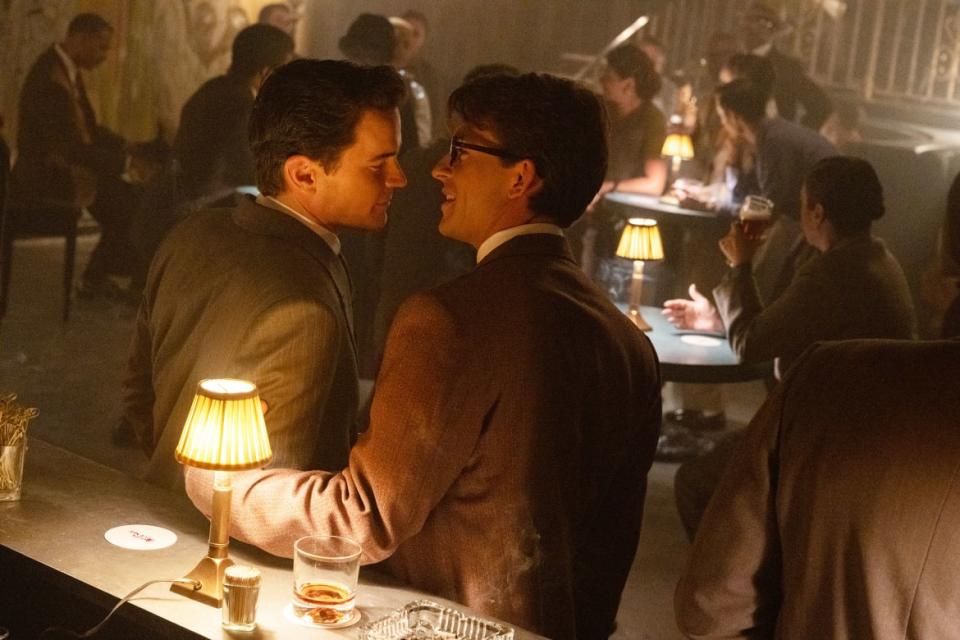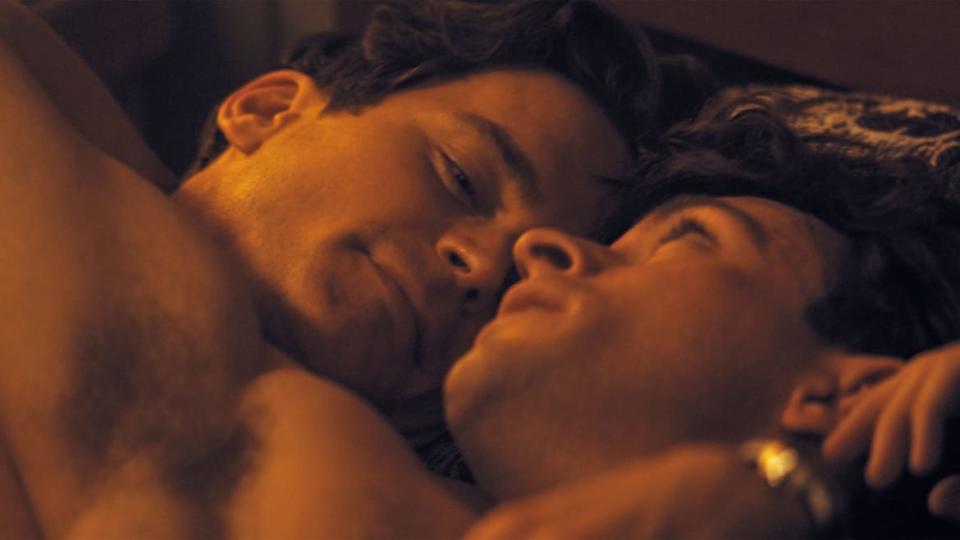The Hot Gay Sex in ‘Fellow Travelers’ Is So Important. We Swear!

You’re forgiven for your inevitable first thought while watching Fellow Travelers: My God, these people are beautiful. The beauty is very much the point of the new limited series, which launches linearly on Showtime Sunday night. (The premiere is currently available to stream on Paramount+ with Showtime.)
Two of television’s most beautiful people, Matt Bomer and Jonathan Bailey, lead the show’s decade-spanning gay love story, which features a supporting cast of fellow beautifuls: Allison Williams, Jelani Aladdin, and Noah J. Ricketts. The backdrop to that beauty include some of the ugliest periods in U.S. history, especially when it comes to the treatment of LGBT+ community and the possibility for queer love. Yet, in Fellow Travelers, the beauty peeks through. (And some extreme hotness, too.)
The series begins in the 1950s at the height of McCarthyism, where Hawk (Bomer) and Tim (Bailey) first meet and begin a passionate, volatile, breathtakingly intimate romance that spans the Lavender Scare, the Vietnam War protest era, the hedonistic ’70s, and the AIDS crisis of ’80s. It’s a relationship defined by secrets and hiding; unflappable intimacy and magnetic connection; betrayal; power; heartbreak and devastation; and rowdy, electric, no-wonder-they-keep-going-back-to-each-other sex. (As showrunner Ron Nyswaner told me about a sex scene in the premiere involving toes, “When I handed in that script, one of the executives said, ‘Wow, I haven’t read that in a script before…’”)
It’s an ambitious series simplified by the spotlight shone on an American truth that’s been long cast to the shadows: This country worked systematically to make it a dangerous near-impossibility for the LGBT+ community to embrace love and survive.

For many viewers, much of Fellow Travelers will be a revelation. Even the most educated among us likely don’t know the details of the Lavender Scare and its persecution of homosexuals conducted via government witch hunt. A byproduct of McCarthyism, suspected gay men and women were targeted, investigated, exposed, and removed from their government positions—a movement that former senator Alan K. Simpson once wrote “harmed far more people” than the communist panic of the Red Scare.
What would it be like to find love during that time, have to hide it, but then also reconnect with it over the span of decades, through to the trauma of the AIDS epidemic? And then, facing that trauma, find the government ignoring the severity of the death toll, essentially persecuting homosexuals once again?
Fellow Travelers doesn’t shy away from sex, just as it doesn’t shy away from the reality of demonization and shame. How can there be shame and joy? How can there be fear and hiding, but also happiness? We talked with Fellow Travelers executive producers Nyswaner (Philadelphia) and Robbie Rogers (My Policeman) about the show’s importance, bringing LGBT+ American history into the light, and the value of great sex scenes amidst it all.
The Astonishing ‘Fellow Travelers’ Is Pornographic Prestige
(Note: These interviews were conducted separately, but consisted of the same talking points.)
The Lavender Scare may be one of the most pivotal moments in queer history, yet most people have no idea that it happened.
Nyswaner: I can’t remember how many people I’ve mentioned the Lavender Scare to—educated, smart people, sophisticated people—who say they’ve never heard of it. So it’s a completely ignored part of American history. And the thing is it can’t in any way be separated from the Red Scare. It can’t be separated from the paranoia of the ’50s.
And yet it so often is, not just in history books but in pop-culture depictions of the time.
Nyswaner: The purge of homosexuals came naturally to people who were clinging to power and building power out of creating fear and paranoia. They just kept finding those ways to continue to scare people, and one way in the ’50s that you could scare people is to say, “The person sitting next to you in your office is a sexual deviant.” “They might leak government secrets because they’ll be blackmailed.” “They’re morally dangerous.” “Keep them away from your children.” So you linked that to your cause of anti-communism, and now your cause is bigger to some people.
Rogers: The LGBT community, we’re not really taught our history. I really didn’t understand the gravity and how many people were affected by the Lavender Scare—the purging of homosexuals, or “deviants” as they called them. I thought it was really interesting to tell a love story that started at that time. You’re keeping your secret so close and the people you love so close, because it’s so dangerous out there.

Not only does the show chronicle these periods of history through Hawk and Tim’s changing relationship, but their relationship is very sexy. Sex isn’t just alluded to, we see it—and it’s hot. Why was it important that we actually show them having sex, and for it to be so realistic?
Nyswaner: We had a rule in the writers room and on the set, which is that every scene, especially the sex scenes, are about power. So an exchange of power between people happens during sex. That’s what gives those scenes a drive and an engine, so they don’t just appear to be like, “Oh, now’s the scene where we get to watch good-looking people have sex.” It’s like, “Oh, at the end of the scene, something has shifted a little bit in each relationship.”
As an added benefit, though, we do get to watch good-looking people have sex.
Nyswaner: True. Kevin, I came out in 1977 or ’78. I was very religious. I still am religious. I was sexually very inexperienced. And I have to say, there’s a joy that we got to experience in the late ’70s, of being liberated and being liberated sexually, and to be with other gay men. Now, I can only speak as a gay man. As a gay man, to be with other gay men and celebrating our newly released and liberated sexuality together was so joyful. And that joy energized our movement. I wanted to really bring that into the show: During periods of oppression, gay people still found joy. And they found it often in sexual relationships with each other.
That relationship to sex, especially sex with each other, is fascinating to watch evolve as Hawk and Tim move through the decades.
Rogers: We wanted to be authentic to the experience of two men who are really in love, and what lust can be created when something is so forbidden. When you know you can go to jail, or your job can be taken away from you, or your family can disown you. Some of my favorite moments are when it’s just after sex or right before sex, and it’s very intimate. We wanted the audience to feel what that desire and that power can feel like when it’s so forbidden—or at least is in your mind. When I was a younger person, it could feel quite dangerous, but also hotter or a little sexier because of that.
Showtime released a teaser clip of a scene in the premiere where Jonathan Bailey appears to go down on Matt Bomer before a party, and people on social media went wild for how hot it was. Having already seen that episode, I was like, you all are this turned on by the scene already, and you have no idea what happens next. [Editor’s note: We won’t spoil what happens.]
Rogers: I know! “This is nothing compared to…” It goes quite far. It’s one element of the series, and it can be a little bit salacious. But we didn’t ever have discussions of, “Oh, this is gonna shock everyone.” What’s happening in that scene is a power play.
Nyswaner: When I handed in that script, one of the executives said, “Wow, I haven’t read that script before…”
✨NEW✨ First clip of Jonny and Matt Bomer in Showtime’s Fellow Travelers!!!#jomathanbailey pic.twitter.com/VrGc6EUGA6
— Jonathan Bailey Daily ✨ (@jbaileydaily) September 19, 2023
We talked about the importance of bringing attention to the Lavender Scare, but this series also spends a lot of time in the ’80s at the height of the AIDS crisis. Why tell the story of these men with those two very dark periods of time as the bookends?
Nyswaner: I did not live through the Lavender Scare. I’m not that old. But the big crisis in my life as a gay man was the AIDS crisis. I wanted to take our audience through the second half of the 20th century, where the LGBT community went from McCarthyism to AIDS. They just felt like such parallel experiences. In one instance, our government was hunting us down and identifying us and destroying lives. And then in the other, our government was letting us die just of pure indifference, because we weren’t significant enough to warrant their interest. We survived both of those periods as a community and post-AIDS—and because of AIDS—deepened and matured as a community. I just felt that was a perfect balance, a way to begin and end a series.
‘Fellow Travelers’ Premiere Recap: The Hottest Television Episode This Year
What will be illuminating to many people, I think, is to see the amount of joy and love that existed in these men’s lives, even while enduring the trauma of those times.
Rogers: People still had fun and had a lot of joy, even as they lost loved ones and had a lot of trauma and sadness. Those things in life always exist. Life’s about trying to embrace both and celebrate the good things, and remember the good things even more when something sad is happening. For people in the younger generation and even myself, it’s really important to look back at these times. We can see how difficult it was for our community, and people could still find hope and optimism.

Ron, you wrote Philadelphia, which won an Oscar for Tom Hanks, who played a man who was fired by his law firm when it was found out that he was gay and had HIV. There were lots of opinions about the film then and now. But having had this experience with Fellow Travelers, what has changed in terms of the way you’re able to tell this kind of story?
Nyswaner: I know that there was criticism of Philadelphia that, in some ways, it was restrained. It wasn’t political enough. It wasn’t sexual enough. Just to be very clear, there were no restraints put on us by a studio. There was no censorship at all. There might have been on the part of myself and Jonathan [Demme, the director]. We were overly cautious, perhaps, because it was new territory. There weren’t mainstream Hollywood movies with homosexual characters dealing with a terrifying illness. So maybe we were overly cautious in some ways, yetI know that movie is really powerful and very effective. I think what is different now is that just having gay characters is no longer pioneering.
That’s true—and certainly is progress.
Nyswaner: To just show queer people live is not dramatic anymore. We have many examples of that. The challenge is to make it true to the queer experience, but maybe expand beyond the queer experience to a human experience. The tagline in the Fellow Travelers promotions is “love is dangerous.” I would say that doesn’t just apply to queer love. All love is dangerous. For Lucy, Hawk’s wife, falling in love with Hawk is dangerous. Loss, grief, heartbreak, and joy are human experiences. They’re not restricted to any identity. I think the challenge now is to embrace the identity, and then also be a little bigger than the identity as well.
That’s a great point to end on.
Nyswaner: I’ll say one more thing: We now can be liberated to have complicated gay antiheroes. No more noble victims. That was another rule in Fellow Travelers. Nobody in the show is a noble victim.
Keep obsessing! Sign up for the Daily Beast’s Obsessed newsletter and follow us on Facebook, Twitter, Instagram and TikTok.
Get the Daily Beast's biggest scoops and scandals delivered right to your inbox. Sign up now.
Stay informed and gain unlimited access to the Daily Beast's unmatched reporting. Subscribe now.

 Yahoo News
Yahoo News 
